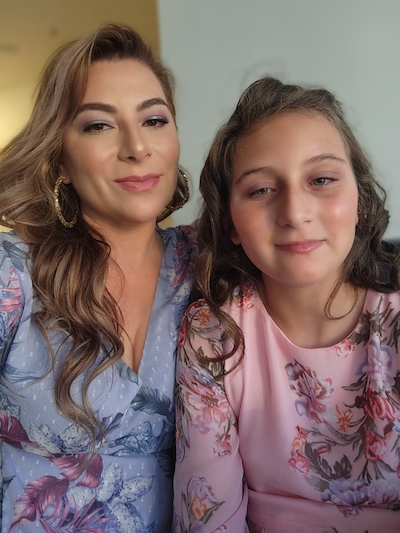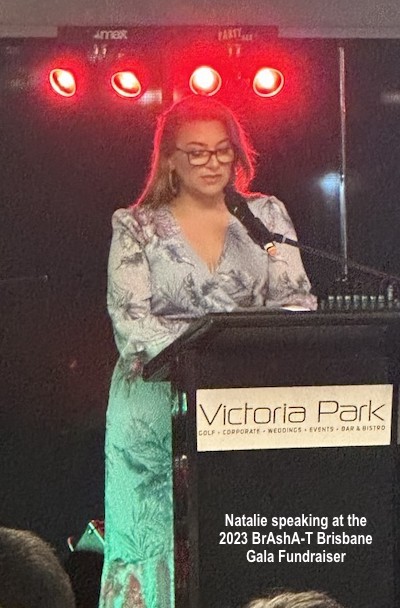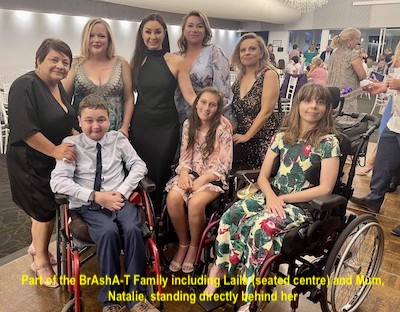Laila
My Family’s Journey with A-T by Laila's Mum, Natalie
 Some of you may know me as the Vice-President of BrAshA-T, the humble charity so many generously support. But while I feel a great sense of honour and responsibility to fulfilling the duties towards BrAshA-T’s goal of fighting for a cure, and the small community it serves, my greatest purpose since her diagnosis 12 years ago has been to serve the needs of my daughter, Laila, who lives with A-T, a role that requires many hats.
Some of you may know me as the Vice-President of BrAshA-T, the humble charity so many generously support. But while I feel a great sense of honour and responsibility to fulfilling the duties towards BrAshA-T’s goal of fighting for a cure, and the small community it serves, my greatest purpose since her diagnosis 12 years ago has been to serve the needs of my daughter, Laila, who lives with A-T, a role that requires many hats.
I am her advocate, her voice in the wider world, ensuring she is always included. I am her hands and feet when they fail her, her shadow, supporting her so that she may always feel a sense of achievement. When her spirits are down, I am her confidante, and her cheerleader, so that she may continually strive towards happiness. Sometimes, I’m just her mum. Her annoying one, if you ask her.
And Before A-T become a part of our world, I WAS just blissfully a mum. That journey began in 2007, when Laila’s father and I were relocating to Brisbane as first time expectant parents. Having been trying for over 8 years, we were finally going to experience the joys of parenthood, we could not contain our delight, and I recall it was a time of excitement, anticipation and overwhelming jubilation!
Also in 2007, whilst I was experiencing the happiest time of my life, a Brisbane family not too far from where we had settled, was experiencing the most devastating time of theirs. Sean and Krissy Roebig had received the news that their 2 youngest children, Brady and Ashleigh, had been diagnosed with the rare children’s disease we know as A-T. A-T is a progressive, degenerative, life-limiting and unrelenting condition affecting a variety of body systems. And the Roebigs didn’t have one child with A-T, they had 2.
As they searched around desperately for support, for information, for treatments, they found nothing. And so they established BrAshA-T, a charity committed to supporting families in Australia living with A-T, whilst funding vital research to find a cure. Unbeknownst to me at the time, the Roebigs had laid the groundwork for what would become the greatest source of hope for me in years to come.
In April 2008, I welcomed into the world my perfect little girl. And as she was placed in my arms for the first time, I felt an immediate and overwhelming sense of love and devotion to her that has never waned. My hopes, my dreams and expectations for this mini me could only be described as infinite, and it was my job to ensure she had the tools to achieve them all.
But as Laila grew, she failed to meet the expected milestones, and it was becoming increasingly apparent that something was amiss. Sure, she couldn’t hold her head up, but that will pass. OK, she looks like a drunken sailor when she walks, that will pass. Yes, yes, her speech is slurred, but that will pass. Only, it didn’t pass. And so started the frustrating 18 month journey to discover why.
No one could give me answers, and testing was excruciatingly slow. We explored many conditions, all of them rare, and each one seemingly worse than the last. But I was never convinced that any of them quite fit Laila’s symptoms. Until one day, when Laila was 3.5 years old, I walked into an opthalmologists office to assess whether her unsteadiness was due to issues with her vision. The doctor reported that actually, Laila’s vision was fine.
 HOWEVER, he said, she does have some red spider veins in her eyes called telangiectasia, which, coupled with her unsteady walking, may be an indication of something called Ataxia-Telangiectasia. I thanked the good doctor for any direction he could give, and I bid him farewell.
HOWEVER, he said, she does have some red spider veins in her eyes called telangiectasia, which, coupled with her unsteady walking, may be an indication of something called Ataxia-Telangiectasia. I thanked the good doctor for any direction he could give, and I bid him farewell.
That evening, I did what every doctor will tell you not to do. I typed the words Ataxia-Telangiectasia into my Google search bar. And as I scrolled through the information, immediately, I knew without any doubt, that this was it. Laila had A-T.
The initial days and weeks following diagnosis were filled with profound devastation and despair as I struggled to come to terms with the fate that awaited Laila. No Immunity, lungs that may fail her, loss of brain cells confining her to a wheelchair by the age of 10, cancer, no treatment, may not survive beyond her teens. The fact that I would have to watch my little girl, so vibrant and full of life, deteriorate before my eyes, was unfathomable, and I could do nothing to prevent it. The feelings of helplessness and hopelessness were crippling. A-T overshadowed everything, and every day was bittersweet.
Unable to face the world, I isolated myself , because nobody truly understood my grief. I had abandoned all my hopes and dreams for Laila, I just simply wanted her to be here tomorrow. I wanted to fill my senses with her, to see her, to hold her, to smell her, to savour every moment with her, so when what I perceived was the inevitable happened, I would have a rich catalogue of memories to call upon at will.
As the months rolled on, I journeyed through my days in a state of numbness. Every morning, the reality of Laila’s diagnosis would dawn on me, and I would have to endure the monumental challenge of climbing a mountain, just to get out of bed. But every morning, oblivious to the fate that awaited her, Laila would wake, armed with an innocent smile and a sense of excitement for the day ahead. Every morning, I would climb that mountain just to keep her smiling. And every morning, Laila was still here, smiling at me.
With the passing of time, my perception began to shift. I had no control of what would come tomorrow, but today, Laila was here, smiling at me. Slowly but surely, she unwittingly pulled me out of my despair, and taught me how to live for today. A-T may take tomorrow, but I could not, and would not, allow it to deny her today.
With that shift in perception, everything changed for me. I wanted to fight, I wanted to outrun A-T, and if A-T won the race, it wasn’t because I hadn’t tried everything in my power to beat it. I at least owed that to my daughter.
And so was born my determination to making a difference to the outcomes for Laila and the 50 odd other known cases of A-T in Australia. This will presented its own set of challenges, because despite what my friends here may think, I am a hopeless introvert, and so I had to find ways to push past my discomfort and engage with family, friends and community to advance our cause. I had to ask the stupid questions, be firm and assertive, and talk about raw and personal experiences that ordinarily would be reserved for my own deep thoghts. I had to present a front that belied the scared, vulnerable and desperate reality within.
Today, as I serve as Vice-President of BrAshA-T for an 8th year, I am so thankful for the legacy left by the Roebigs, and I am proud of the advances we have made in our fight for a cure since taking hold of the reigns. Initiatives such as funding a National A-T Clinic, accessible to all A-T patients in Australia, which alone has seen a significant improvement in the health outcomes of our patient base, and which laid the groundwork for the first ever Australian led clinical trial for A-T spearheaded by Dr David Coman, giving hope to families all around the world living with A-T.
Being such a small and rare community affords us the unique privilege of having a close collaborative relationship with our clinicians and researchers. Backed by the support of change-making organisations like the Wesley Medical Research, it has proven to be a winning formula in advancing our goals towards a treatment for A-T.
As a parent of a child with A-T, I am entrusted with the burden of Laila’s care whilst trying to be an advocate for her within a system that largely places no value on her survival simply because there aren’t enough like her, and it may not be economically rewarding to invest in her treatment. So to have industry heavy weights not only supporting, but driving A-T research, puts us in an enviable position for a rare disease, and for which our families are infinitely grateful.
 In addition to funding research, BrAshA-T also offers a first port of call to families after receiving a diagnosis of A-T for their child. By far, my most rewarding and equally harrowing role is to speak with a mother or father consumed with grief, loss, and despair in the initial days and months following their child’s diagnosis. After listening to their seemingly inconsolable pain, and acknowledging their fears, I gently reassure them to ignore what Google told them, I have another story to tell you. One of an A-T family who will hold them up through their darkest days. One of exciting discoveries led by world renowned researchers on our very shores, one of collaboration with equally motivated A-T charities as part of our Global A-T Alliance, one of multiple promising clinical trials from all corners of the globe, including one in Brisbane. One of science moving at an extraordinary pace with the potential for imminent breakthroughs in the field of genetic correction, a story with yet an unwritten, but imminent, ending that WILL end with a cure.
In addition to funding research, BrAshA-T also offers a first port of call to families after receiving a diagnosis of A-T for their child. By far, my most rewarding and equally harrowing role is to speak with a mother or father consumed with grief, loss, and despair in the initial days and months following their child’s diagnosis. After listening to their seemingly inconsolable pain, and acknowledging their fears, I gently reassure them to ignore what Google told them, I have another story to tell you. One of an A-T family who will hold them up through their darkest days. One of exciting discoveries led by world renowned researchers on our very shores, one of collaboration with equally motivated A-T charities as part of our Global A-T Alliance, one of multiple promising clinical trials from all corners of the globe, including one in Brisbane. One of science moving at an extraordinary pace with the potential for imminent breakthroughs in the field of genetic correction, a story with yet an unwritten, but imminent, ending that WILL end with a cure.
Now, this is where your support makes the greatest impact. It offers the families of children diagnosed with A-T that most important, intangible, immeasurable factor that keeps us pushing through each day. HOPE. Hope for a better tomorrow for our kids, for any tomorrow. Hope that someone better equipped than us is working tirelessly to improve our children’s prognosis, allowing us to focus on their joy, despite their increasing challenges. Hope that lifts us out of our despair and isolation, hope of sparing our children from the ravages of A-T, hope of a cure. YOU are the difference between hope and hopelessness,
Over the past 12 years, I have had the privilege of meeting many A-T superstars, but sadly, not all have made it through. My commitment to fight for a cure is equally in honour of those we’ve lost, and those left behind, because if I don’t make an effort, then who will? It is an unforgiving, unrelenting burden that pales in comparison to my own daughter’s daily struggles as she faces each day with a steady determination in spite of the fact that her body is failing her. As I struggle to watch her deteriorate, having come full circle back to those initial feelings of despair as A-T appears to be winning the race, I yearn for that promise of possibility that comes with childhood innocence that once sparkled in her eyes that appears to be fading. Or is it just a reflection of my own increasing anguish, magnified by a sense of failure that I did not run fast enough? And if I told you that I make promises to her that I don’t know if I can keep, at least for her, when she asks me “Mummy, can you fix me?”, I ask you to consider this, what lengths would you go to if it was your child?
Natalie Elkheir, March 2023